Ultra-Low Dose CT Chest in Acute COVID-19 Pneumonia: A Pilot Study from India
Abstract
1. Introduction
2. Materials and Methods
2.1. Study Design and Sample
2.2. CT Acquisition and Protocol
2.3. Image Interpretation and Analysis
2.4. Dose Calculation
2.5. Statistical Analysis
- 0–0.20, poor agreement;
- 0.21–0.40, fair agreement;
- 0.41–0.60, moderate agreement;
- 0.61–0.80, substantial agreement; and
- 0.81–1.00, almost perfect agreement.
- A p-value of less than 0.05 was considered statistically significant.
3. Results
4. Discussion
5. Conclusions
Author Contributions
Funding
Institutional Review Board Statement
Informed Consent Statement
Data Availability Statement
Acknowledgments
Conflicts of Interest
References
- Garg, M.; Prabhakar, N.; Bhalla, A.; Irodi, A.; Sehgal, I.; Debi, U.; Suri, V.; Agarwal, R.; Yaddanapudi, L.; Puri, G.; et al. Computed tomography chest in COVID-19: When & why? Indian J. Med. Res. 2021, 153, 86–92. [Google Scholar] [CrossRef]
- Kwee, T.C.; Kwee, R.M. Chest CT in COVID-19: What the Radiologist Needs to Know. Radiographics 2020, 40, 1848–1865, Erratum in Radiographics 2022, 42, E32. [Google Scholar] [CrossRef]
- Kohli, A.; Joshi, A.; Shah, A.; Jain, R.D.; Gorlawar, A.; Dhapare, A.; Desai, J.; Shetty, A.; Shah, C.; Ostwal, P.; et al. Does CT help in reducing RT-PCR false negative rate for COVID-19? Indian J. Radiol. Imaging 2021, 31 (Suppl. 1), S80–S86. [Google Scholar] [CrossRef]
- Garg, M.; Maralakunte, M.; Garg, S.; Dhooria, S.; Sehgal, I.; Bhalla, A.S.; Vijayvergiya, R.; Grover, S.; Bhatia, V.; Jagia, P.; et al. The Conundrum of ‘Long-COVID-19’: A Narrative Review. Int. J. Gen. Med. 2021, 14, 2491–2506. [Google Scholar] [CrossRef]
- Garg, M.; Prabhakar, N.; Bhatia, H.; Dhooria, S.; Debi, U.; Muthu, V.; Maralkunte, M.; Sehgal, I.; Agarwal, R.; Sandhu, M. CT findings in sequel of COVID-19 pneumonia and its complications. BJR Open 2021, 2, 20210055. [Google Scholar] [CrossRef]
- Garg, M.; Prabhakar, N.; Muthu, V.; Farookh, S.; Kaur, H.; Suri, V.; Agarwal, R. CT Findings of COVID-19-associated Pulmonary Mucormycosis: A Case Series and Literature Review. Radiology 2022, 302, 214–217. [Google Scholar] [CrossRef]
- Naranje, P.; Bhalla, A.S.; Jana, M.; Garg, M.; Nair, A.D.; Singh, S.K.; Banday, I. Imaging of Pulmonary Superinfections and Co-Infections in COVID-19. Curr. Probl. Diagn. Radiol. 2022, 51, 768–778. [Google Scholar] [CrossRef]
- Zhou, Y.; Zheng, Y.; Wen, Y.; Dai, X.; Liu, W.; Gong, Q.; Huang, C.; Lv, F.; Wu, J. Radiation dose levels in chest computed tomography scans of coronavirus disease 2019 pneumonia: A survey of 2119 patients in Chongqing, southwest China. Medicine 2021, 100, e26692. [Google Scholar] [CrossRef]
- Devic, C.; Bodgi, L.; Sonzogni, L.; Pilleul, F.; Ribot, H.; De Charry, C.; Le Moigne, F.; Paul, D.; Carbillet, F.; Munier, M.; et al. Influence of cellular models and individual factor in the biological response to chest CT scan exams. Eur. Radiol. Exp. 2022, 6, 14. [Google Scholar] [CrossRef]
- The 2007 Recommendations of the International Commission on Radiological Protection. ICRP publication 103. Ann. ICRP 2007, 37, 1–332. [CrossRef]
- McCollough, C.; Cody, D.; Edyvean, S.; Geise, R.; Gould, B.; Keat, N.; Huda, W.; Judy, P.; Kalender, W.; McNitt-Gray, M.; et al. The Measurement, Reporting, and Management of Radiation Dose in CT; Report of AAPM Task Group; American Association of Physicists in Medicine: Alexandria, VA, USA, 2008; Volume 23, pp. 1–28. [Google Scholar] [CrossRef]
- American Association of Physicists in Medicine (AAPM) Lung Cancer Screening CT Protocols Version 5.1. 2019. Available online: https://www.aapm.org/pubs/CTProtocols/documents/LungCancerScreeningCT.pdf (accessed on 12 August 2021).
- Kim, Y.; Kim, Y.K.; Lee, B.E.; Lee, S.J.; Ryu, Y.J.; Lee, J.H.; Chang, J.H. Ultra-Low-Dose CT of the Thorax Using Iterative Reconstruction: Evaluation of Image Quality and Radiation Dose Reduction. AJR Am. J. Roentgenol. 2015, 204, 1197–1202. [Google Scholar] [CrossRef] [PubMed]
- Fujita, M.; Higaki, T.; Awaya, Y.; Nakanishi, T.; Nakamura, Y.; Tatsugami, F.; Baba, Y.; Iida, M.; Awai, K. Lung cancer screening with ultra-low dose CT using full iterative reconstruction. Jpn. J. Radiol. 2017, 35, 179–189. [Google Scholar] [CrossRef]
- Suntharalingam, S.; Mikat, C.; Wetter, A.; Guberina, N.; Salem, A.; Heil, P.; Forsting, M.; Nassenstein, K. Whole-body ultra-low dose CT using spectral shaping for detection of osteolytic lesion in multiple myeloma. Eur. Radiol. 2018, 28, 2273–2280. [Google Scholar] [CrossRef]
- Pan, F.; Ye, T.; Sun, P.; Gui, S.; Liang, B.; Li, L.; Zheng, D.; Wang, J.; Hesketh, R.; Yang, L.; et al. Time Course of Lung Changes at Chest CT during Recovery from Coronavirus Disease 2019 (COVID-19). Radiology 2020, 295, 715–721. [Google Scholar] [CrossRef]
- Deak, P.D.; Smal, Y.; Kalender, W.A. Multisection CT protocols: Sex- and age-specific conversion factors used to determine effective dose from dose-length product. Radiology 2010, 257, 158–166. [Google Scholar] [CrossRef]
- Zhao, Y.-M.; Shang, Y.-M.; Song, W.-B.; Li, Q.-Q.; Xie, H.; Xu, Q.-F.; Jia, J.-L.; Li, L.-M.; Mao, H.-L.; Zhou, X.-M.; et al. Follow-up study of the pulmonary function and related physiological characteristics of COVID-19 survivors three months after recovery. EClinicalMedicine 2020, 25, 100463. [Google Scholar] [CrossRef]
- Garg, M.; Gupta, P.; Maralakunte, M.; Kumar-M, P.; Sinha, A.; Kang, M.; Agarwal, R.; Sandhu, M.S. Diagnostic accuracy of CT and radiographic findings for novel coronavirus 2019 pneumonia: Systematic review and meta-analysis. Clin. Imaging 2021, 72, 75–82. [Google Scholar] [CrossRef]
- Homayounieh, F.; Holmberg, O.; Al Umairi, R.; Aly, S.; Basevičius, A.; Costa, P.R.; Darweesh, A.; Gershan, V.; Ilves, P.; Kostova-Lefterova, D.; et al. Variations in CT Utilization, Protocols, and Radiation Doses in COVID-19 Pneumonia: Results from 28 Countries in the IAEA Study. Radiology 2021, 298, E141–E151. [Google Scholar] [CrossRef]
- Garg, M.; Karami, V.; Moazen, J.; Kwee, T.; Bhalla, A.S.; Shahbazi-Gahrouei, D.; Shao, Y.-H.J. Radiation Exposure and Lifetime Attributable Risk of Cancer Incidence and Mortality from Low- and Standard-Dose CT Chest: Implications for COVID-19 Pneumonia Subjects. Diagnostics 2022, 12, 3043. [Google Scholar] [CrossRef]
- Garg, M.; Lamicchane, S.; Maralakunte, M.; Debi, U.; Dhooria, S.; Sehgal, I.; Prabhakar, N.; Sandhu, M.S. Role of MRI in the Evaluation of Pulmonary Sequel Following COVID-19 Acute Respiratory Distress Syndrome (ARDS). Curr. Probl. Diagn. Radiol. 2022. online ahead of print. [Google Scholar] [CrossRef]
- Garg, M.; Prabhakar, N.; Dhooria, S.; Lamichhane, S. Magnetic resonance imaging (MRI) chest in post-COVID-19 pneumonia. Lung India 2021, 38, 498–499. [Google Scholar] [CrossRef]
- Zarei, F.; Jalli, R.; Chatterjee, S.; Haghighi, R.R.; Iranpour, P.; Chatterjee, V.V.; Emadi, S. Evaluation of Ultra-Low-Dose Chest Computed Tomography Images in Detecting Lung Lesions Related to COVID-19: A Prospective Study. Iran. J. Med. Sci. 2022, 47, 338–349. [Google Scholar] [CrossRef]
- Greffier, J.; Hoballah, A.; Sadate, A.; de Oliveira, F.; Claret, P.-G.; de Forges, H.; Loubet, P.; Mauboussin, J.-M.; Hamard, A.; Beregi, J.-P.; et al. Ultra-low-dose chest CT performance for the detection of viral pneumonia patterns during the COVID-19 outbreak period: A monocentric experience. Quant. Imaging Med. Surg. 2021, 11, 3190–3199. [Google Scholar] [CrossRef] [PubMed]
- Samir, A.; El-Husseiny, R.M.; Sweed, R.A.; El-Maaboud, N.A.E.-M.A.; Masoud, M. Ultra-low-dose chest CT protocol during the second wave of COVID-19 pandemic: A double-observer prospective study on 250 patients to evaluate its detection accuracy. Egypt. J. Radiol. Nucl. Med. 2021, 52, 136. [Google Scholar] [CrossRef]
- Bahrami-Motlagh, H.; Moharamzad, Y.; Amoli, G.I.; Abbasi, S.; Abrishami, A.; Khazaei, M.; Davarpanah, A.H.; Taheri, M.S. Agreement between low-dose and ultra-low-dose chest CT for the diagnosis of viral pneumonia imaging patterns during the COVID-19 pandemic. Egypt. J. Radiol. Nucl. Med. 2022, 53, 14. [Google Scholar] [CrossRef]
- Tabatabaei, S.M.H.; Talari, H.; Gholamrezanezhad, A.; Farhood, B.; Rahimi, H.; Razzaghi, R.; Mehri, N.; Rajebi, H. A low-dose chest CT protocol for the diagnosis of COVID-19 pneumonia: A prospective study. Emerg. Radiol. 2020, 27, 607–615. [Google Scholar] [CrossRef]
- Dangis, A.; Gieraerts, C.; De Bruecker, Y.; Janssen, L.; Valgaeren, H.; Obbels, D.; Gillis, M.; Van Ranst, M.; Frans, J.; Demeyere, A.; et al. Accuracy and Reproducibility of Low-Dose Submillisievert Chest CT for the Diagnosis of COVID-19. Radiol. Cardiothorac. Imaging 2020, 2, e200196. [Google Scholar] [CrossRef]
- Elgazzar, A.H.; Kazem, N. Biological effects of ionizing radiation. In The Pathophysiologic Basis of Nuclear Medicine; Springer: Cham, Switzerland, 2015; pp. 715–726. [Google Scholar]
- Garg, M.; Prabhakar, N.; Bhalla, A.S. Cancer risk of CT scan in COVID-19: Resolving the dilemma. Indian J. Med. Res. 2021, 153, 568–571. [Google Scholar] [CrossRef]
- Sakane, H.; Ishida, M.; Shi, L.; Fukumoto, W.; Sakai, C.; Miyata, Y.; Ishida, T.; Akita, T.; Okada, M.; Awai, K.; et al. Biological Effects of Low-Dose Chest CT on Chromosomal DNA. Radiology 2020, 295, 439–445. [Google Scholar] [CrossRef]
- Kroft, L.J.M.; van der Velden, L.; Girón, I.H.; Roelofs, J.J.H.; de Roos, A.; Geleijns, J. Added Value of Ultra-low-dose Computed Tomography, Dose Equivalent to Chest X-Ray Radiography, for Diagnosing Chest Pathology. J. Thorac. Imaging 2019, 34, 179–186. [Google Scholar] [CrossRef]
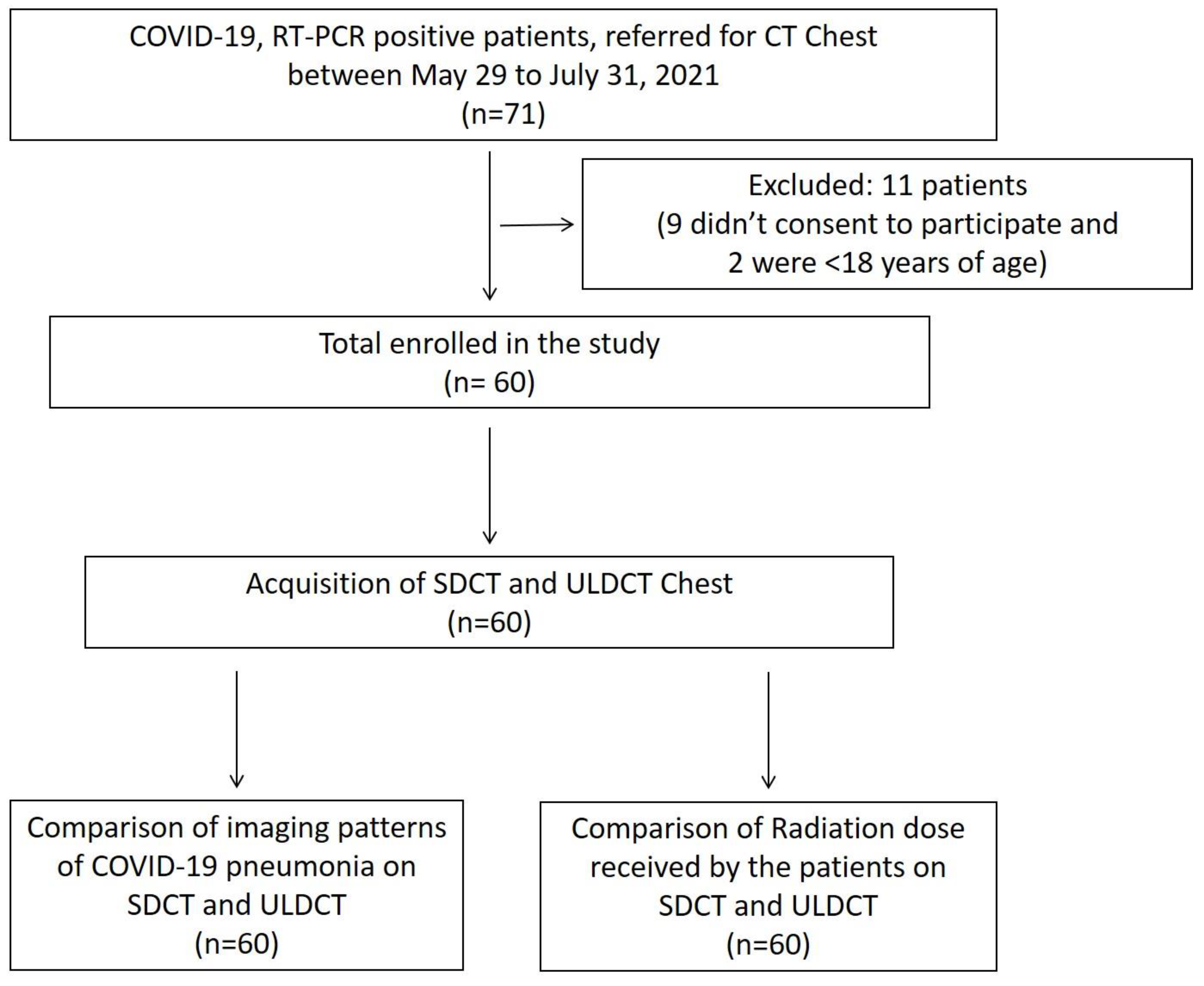
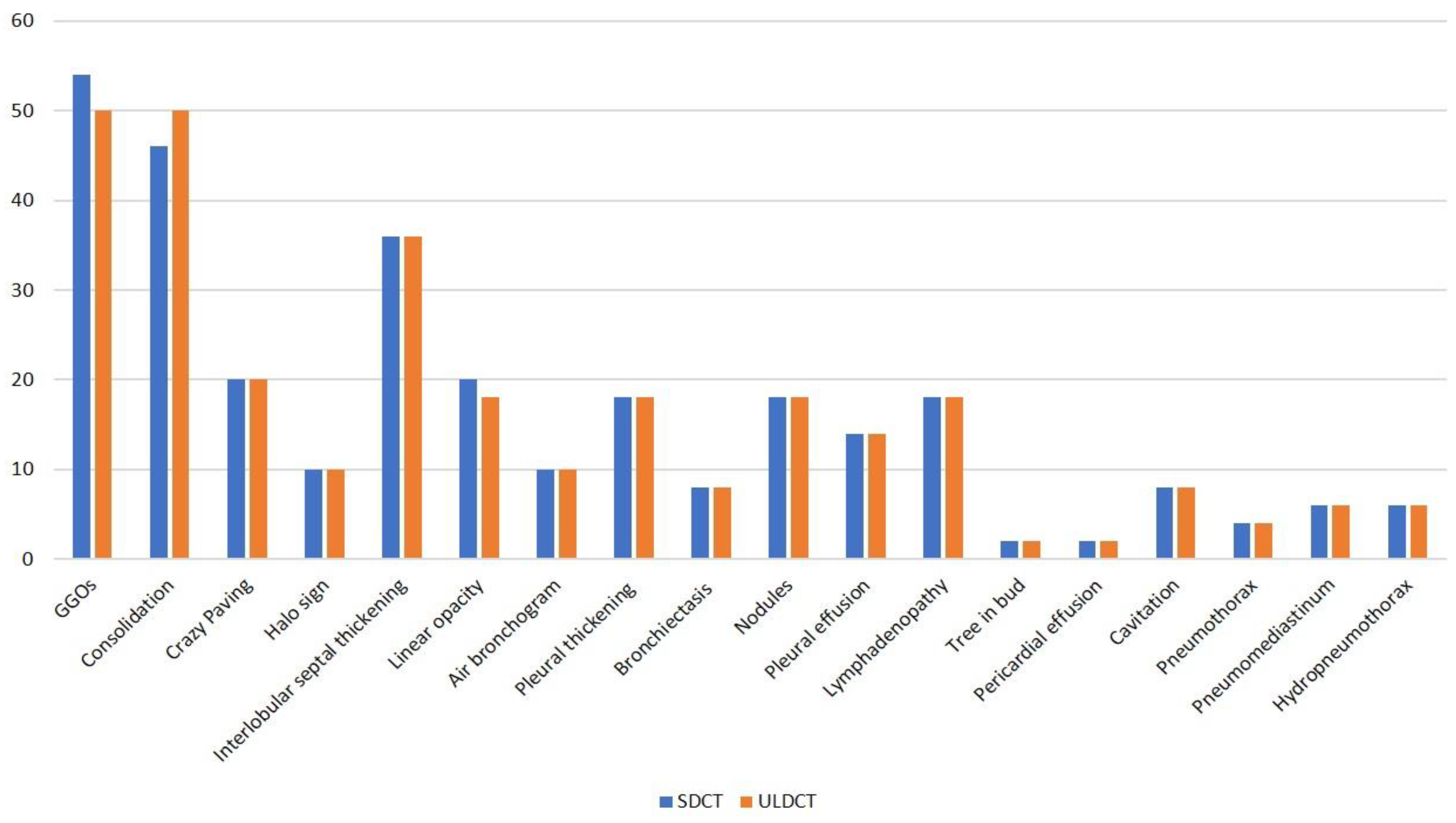
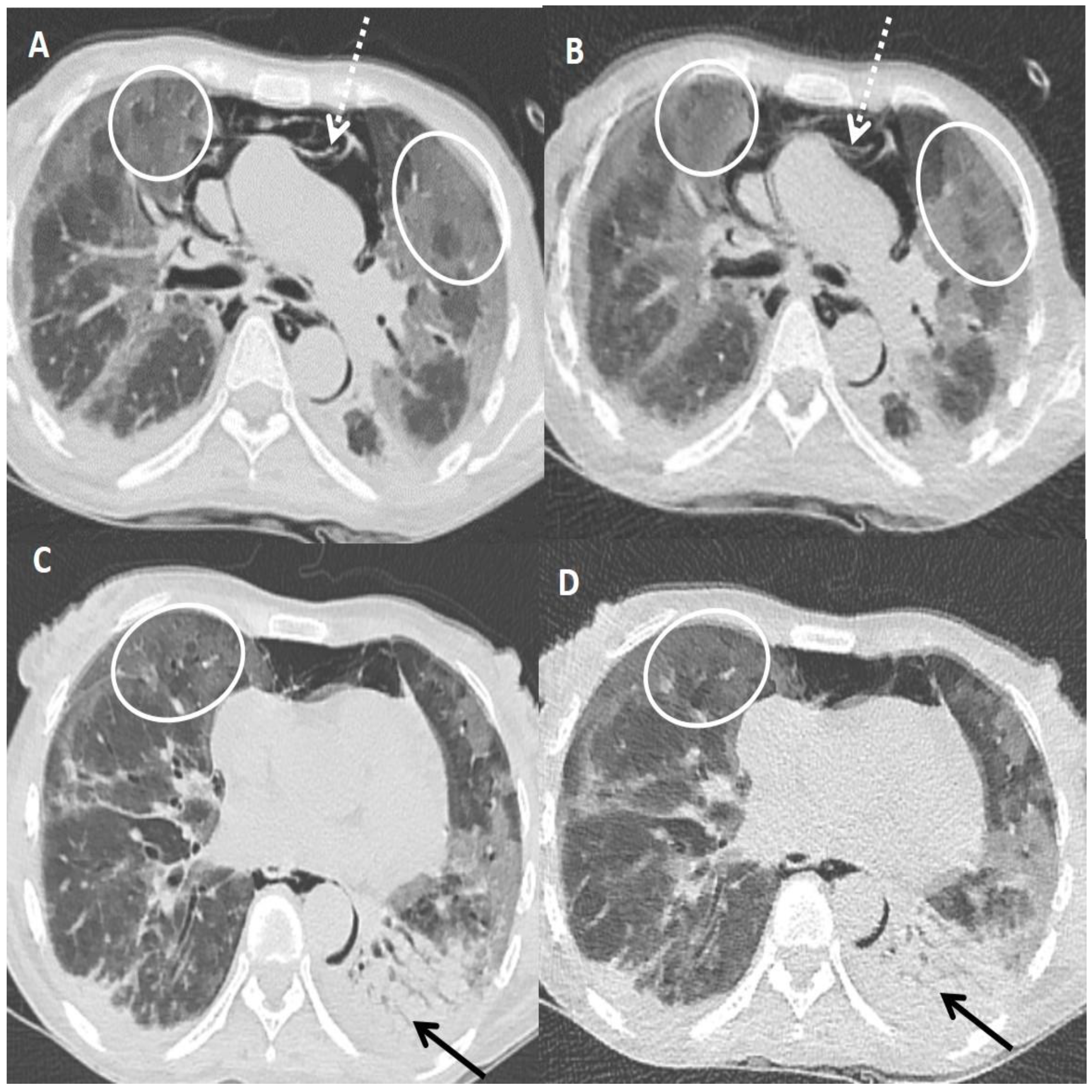
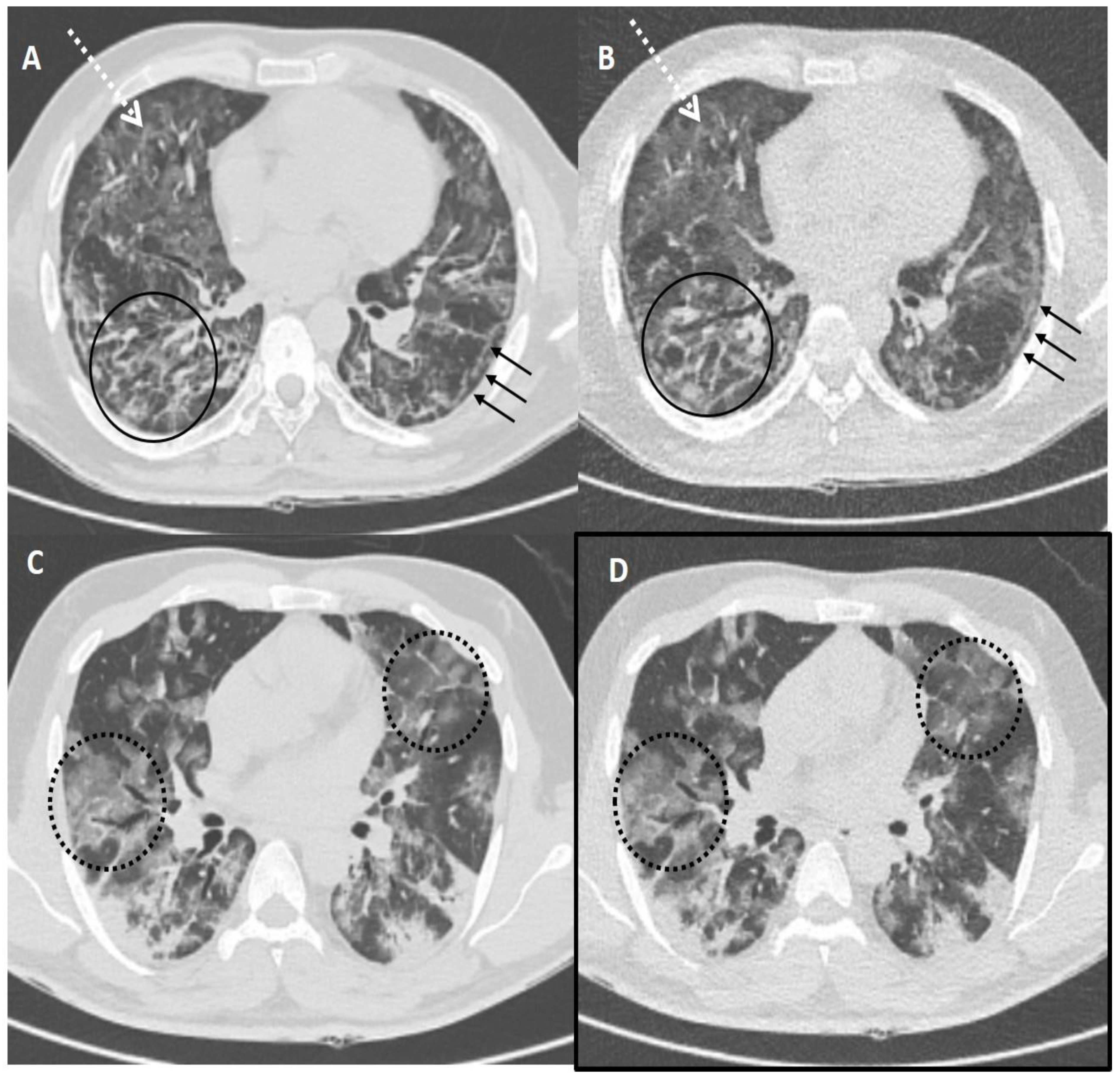
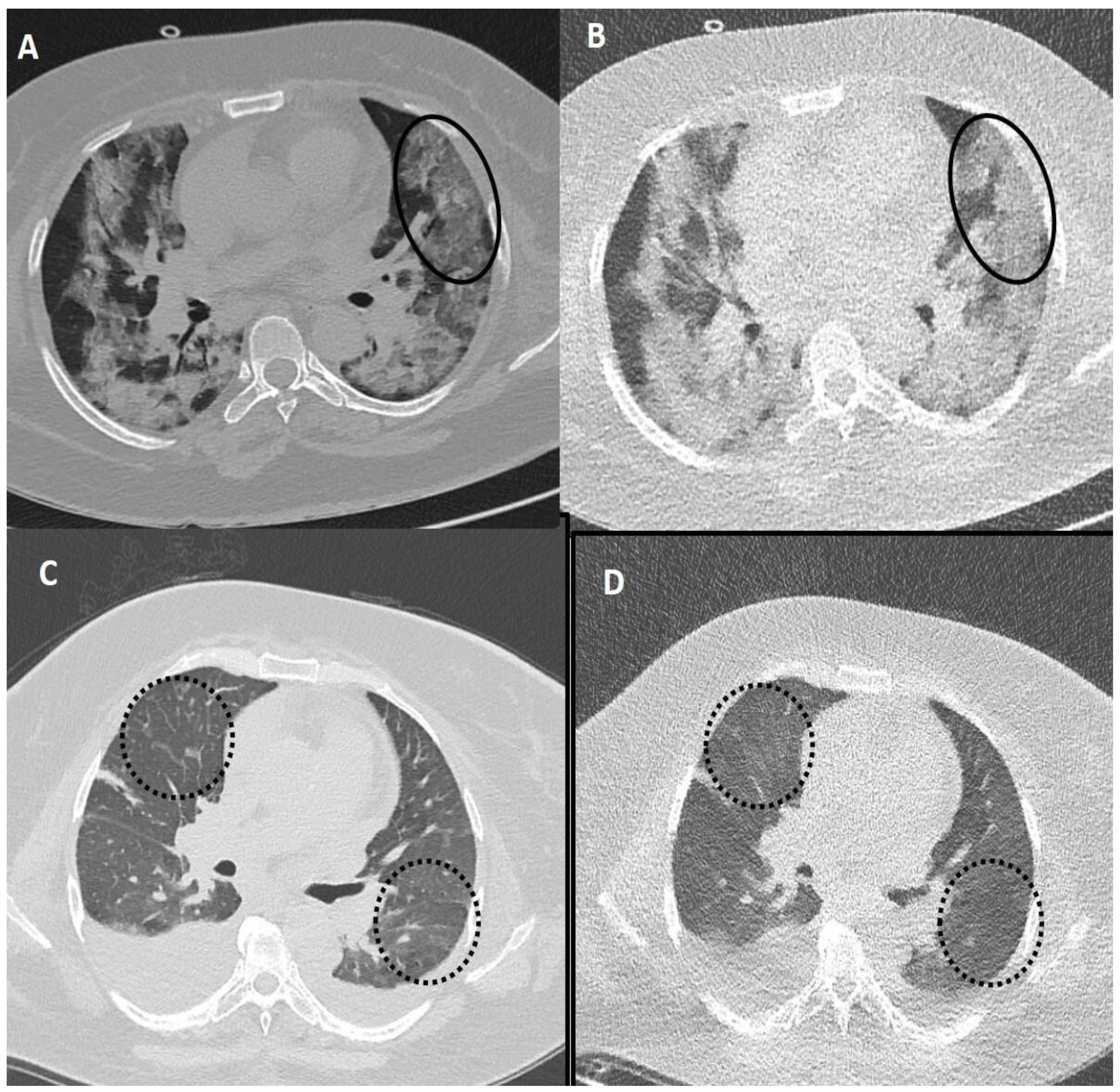
| Parameters | SDCT Chest | ULDCT Chest |
|---|---|---|
| Scanning mode | Helical | Helical |
| Tube potential (kV) | 120 | 80 |
| Tube current time (mAs) | AEC modulated | 25 |
| Tube current modulation technique | AEC | Fixed tube current |
| Pitch | 0.758 | 0.758 |
| Rotation time (s) | 0.5 | 0.5 |
| Slice thickness (in mm) | 10 | 10 |
| Iterative reconstruction technique | Hybrid iterative reconstruction software iDose level 6 | Hybrid iterative reconstruction software iDose level 6 |
| Orientation | Head first | Head first |
| Patient Characteristics | Observations (n = 60) |
|---|---|
| Demographics | Frequency |
| Age (years) | 47.2 ± 10.7 (mean ± S.D) |
| Gender | Frequency |
| Male | 40 (66.67%) |
| Female | 20 (33.33%) |
| Clinical features | Frequency |
| Fever | 54 (90.00%) |
| Cough | 58 (96.67%) |
| Dyspnea | 48 (80.00%) |
| Myalgia | 30 (50.00%) |
| Fatigue | 30 (50.00%) |
| Anosmia or ageusia | 38 (63.33%) |
| Sore throat | 30 (50.00%) |
| Clinical history | Frequency |
| Diabetes | 20 (33.33%) |
| Hypertension | 18 (30.00%) |
| CKD | 6 (5.00%) |
| Coronary artery disease | 4 (6.67%) |
| COPD | 2 (3.33%) |
| Past history of tuberculosis | 5 (8.33%) |
| Smoker | 14 (23.33%) |
| Alcoholic | 15 (25.00%) |
| Laboratory data | Frequency |
| Anaemia | 9 (15.00%) |
| Leucocytosis | 10 (16.67%) |
| Thrombocytopenia | 7 (11.67%) |
| Deranged RFT | 6 (5.00%) |
| Raised LDH | 40 (66.67%) |
| Raised CRP | 42 (70.00%) |
| Raised procalcitonin | 30 (50.00%) |
| Raised ferritin | 34 (56.66%) |
| Raised troponin T | 24 (40.00%) |
| Raised d-dimer | 32 (53.33%) |
| Duration from: | Days |
| Symptom to CT scan | 11.2 ± 2.2 (mean ± S.D) |
| RT-PCR to CT scan | 8 ± 2.5 (mean ± S.D) |
| Distribution of lung abnormalities | Frequency |
| Bilateral | 60 (100%) |
| Peripheral | 38 (63.33%) |
| Diffuse | 18 (30.00%) |
| Random | 4 (6.67%) |
| RUL | 46 (76.67%) |
| RML | 52 (86.67%) |
| RLL | 60 (100%) |
| LUL | 46 (76.67%) |
| LLL | 54 (90.00%) |
| Dose Indices and Image Quality | SDCT | ULDCT | |
|---|---|---|---|
| CTDIvol (mGy) | 9.45 ± 2.70 (mean ± S.D) | 0.5 ± 00 (mean ± S.D) | |
| DLP (mGycm) | 352.57 ± 79.36 (mean ± S.D) | 18.59 ± 1.72 (mean ± S.D) | |
| Effective radiation dose (mSv) | 4.93 ± 1.11 (mean ± S.D) | 0.26 ± 0.02 (mean ± S.D) | |
| Net effective radiation dose reduction | 94.38 ± 1.7% (mean ± S.D) | ||
| SNR | 31.35 ± 3.32 (mean ± S.D) | 14.53 ± 1.55 (mean ± S.D) | |
| Noise | No or minimum | 60 (100%) | 54 (90%) |
| Acceptable | 0% | 4 (6.67%) | |
| Unacceptable | 0% | 2 (3.33%) | |
| Sharpness | Sharp | 60 (100%) | 54 (90%) |
| Average | 0% | 6 (10%) | |
| Blurry | 0% | 0% | |
| Artifact | Absent | 54 (90%) | 52 (86.67%) |
| Present but not affecting diagnostic confidence | 6 (10%) | 8 (13.33%) | |
| Present and affecting diagnostic confidence | 0% | 0% | |
| Diagnostic confidence | High | 60 (100%) | 56 (93.33%) |
| Acceptable | 0% | 4 (6.67%) | |
| Poor | 0% | 0% | |
| Imaging Patterns | TP | TN | FP | FN | Sensitivity | Specificity | PPV | NPV | Diagnostic Accuracy | Kappa | p-Value |
|---|---|---|---|---|---|---|---|---|---|---|---|
| GGOs | 50 | 6 | 0 | 4 | 92.59% (82.11–97.94%) | 100.00% (54.07–100.00%) | 100.00% (88.1–100%) | 60.00% (36.88–79.39%) | 93.33% (83.80–98.15%) | 0.82 | <0.001 |
| Consolidation | 46 | 10 | 4 | 0 | 100.00% (92.29–100.00%) | 71.43% (41.90–91.61%) | 92.00% (83.40–96.34%) | 100.00% (78.14–100%) | 93.33% (83.80–98.15%) | 0.82 | <0.001 |
| Crazy paving | 20 | 40 | 0 | 0 | 100.00% (83.16–100.00%) | 100.00% (91.19–100.00%) | 100.00% (83.16–100.00%) | 100.00% (91.19–100.00%) | 100.00% (94.04–100.00%) | 1 | <0.001 |
| Halo sign | 10 | 50 | 0 | 0 | 100.00% (69.15–100.00%) | 100.00% (92.89–100.00%) | 100.00% (69.15–100.00%) | 100.00% (92.89–100.00%) | 100.00% (94.04–100.00%) | 1 | <0.001 |
| Septal thickening/reticulation | 36 | 24 | 0 | 0 | 100.00% (90.26–100.00%) | 100.00% (85.75–100.00%) | 100.00% (90.26–100.00%) | 100.00% (85.75–100.00%) | 100.00% (94.04–100.00%) | 1 | <0.001 |
| Linear opacity | 18 | 40 | 0 | 2 | 90.00% (68.30–98.77%) | 100.00% (91.19–100.00%) | 100.00% (76.2–100%) | 95.23% (84.30–98.68%) | 96.67% (88.47–99.59%) | 0.95 | <0.001 |
| Air bronchogram | 10 | 50 | 0 | 0 | 100.00% (69.15–100.00%) | 100.00% (92.89–100.00%) | 100.00% (69.15–100.00%) | 100.00% (92.89–100.00%) | 100.00% (94.04–100.00%) | 1 | <0.001 |
| Pleural thickening | 18 | 42 | 0 | 0 | 100.00% (81.47–100.00%) | 100.00% (91.59–100.00%) | 100.00% (81.47–100.00%) | 100.00% (91.59–100.00%) | 100.00% (94.04–100.00%) | 1 | <0.001 |
| Bronchiectasis | 8 | 52 | 0 | 0 | 100.00% (63.06–100.00%) | 100.00% (93.15–100.00%) | 100.00% (63.06–100.00%) | 100.00% (93.15–100.00%) | 100.00% (94.04–100.00%) | 1 | <0.001 |
| Nodules | 18 | 42 | 0 | 0 | 100.00% (81.47–100.00%) | 100.00% (91.59–100.00%) | 100.00% (81.47–100.00%) | 100.00% (91.59–100.00%) | 100.00% (94.04–100.00%) | 1 | <0.001 |
| Pleural effusion | 14 | 46 | 0 | 0 | 100.00% (76.84–100.00%) | 100.00% (92.29–100.00%) | 100.00% (76.84–100.00%) | 100.00% (92.29–100.00%) | 100.00% (94.04–100.00%) | 1 | <0.001 |
| Lymphadenopathy | 18 | 42 | 0 | 0 | 100.00% (81.47–100.00%) | 100.00% (91.59–100.00%) | 100.00% (81.47–100.00%) | 100.00% (91.59–100.00%) | 100.00% (94.04–100.00%) | 1 | <0.001 |
| Tree-in-bud | 2 | 58 | 0 | 0 | 100.00% (15.81–100.00%) | 100.00% (93.84–100.00%) | 100.00% (15.81–100.00%) | 100.00% (93.84–100.00%) | 100.00% (94.04–100.00%) | 1 | <0.001 |
| Pericardial effusion | 2 | 58 | 0 | 0 | 100.00% (15.81–100.00%) | 100.00% (93.84–100.00%) | 100.00% (15.81–100.00%) | 100.00% (93.84–100.00%) | 100.00% (94.04–100.00%) | 1 | <0.001 |
| Cavitation | 8 | 52 | 0 | 0 | 100.00% (63.06–100.00%) | 100.00% (93.15–100.00%) | 100.00% (63.06–100.00%) | 100.00% (93.15–100.00%) | 100.00% (94.04–100.00%) | 1 | <0.001 |
| Pneumothorax | 4 | 56 | 0 | 0 | 100.00% (39.76–100.00%) | 100.00% (93.62–100.00%) | 100.00% (39.76–100.00%) | 100.00% (93.62–100.00%) | 100.00% (94.04–100.00%) | 1 | <0.001 |
| Pneumomediastinum | 6 | 54 | 0 | 0 | 100.00% (54.07–100.00%) | 100.00% (93.40–100.00%) | 100.00% (54.07–100.00%) | 100.00% (93.40–100.00%) | 100.00% (94.04–100.00%) | 1 | <0.001 |
| Hydropneumothorax | 6 | 54 | 0 | 0 | 100.00% (54.07–100.00%) | 100.00% (93.40–100.00%) | 100.00% (54.07–100.00%) | 100.00% (93.40–100.00%) | 100.00% (94.04–100.00%) | 1 | <0.001 |
Disclaimer/Publisher’s Note: The statements, opinions and data contained in all publications are solely those of the individual author(s) and contributor(s) and not of MDPI and/or the editor(s). MDPI and/or the editor(s) disclaim responsibility for any injury to people or property resulting from any ideas, methods, instructions or products referred to in the content. |
© 2023 by the authors. Licensee MDPI, Basel, Switzerland. This article is an open access article distributed under the terms and conditions of the Creative Commons Attribution (CC BY) license (https://creativecommons.org/licenses/by/4.0/).
Share and Cite
Garg, M.; Devkota, S.; Prabhakar, N.; Debi, U.; Kaur, M.; Sehgal, I.S.; Dhooria, S.; Bhalla, A.; Sandhu, M.S. Ultra-Low Dose CT Chest in Acute COVID-19 Pneumonia: A Pilot Study from India. Diagnostics 2023, 13, 351. https://doi.org/10.3390/diagnostics13030351
Garg M, Devkota S, Prabhakar N, Debi U, Kaur M, Sehgal IS, Dhooria S, Bhalla A, Sandhu MS. Ultra-Low Dose CT Chest in Acute COVID-19 Pneumonia: A Pilot Study from India. Diagnostics. 2023; 13(3):351. https://doi.org/10.3390/diagnostics13030351
Chicago/Turabian StyleGarg, Mandeep, Shritik Devkota, Nidhi Prabhakar, Uma Debi, Maninder Kaur, Inderpaul S. Sehgal, Sahajal Dhooria, Ashish Bhalla, and Manavjit Singh Sandhu. 2023. "Ultra-Low Dose CT Chest in Acute COVID-19 Pneumonia: A Pilot Study from India" Diagnostics 13, no. 3: 351. https://doi.org/10.3390/diagnostics13030351
APA StyleGarg, M., Devkota, S., Prabhakar, N., Debi, U., Kaur, M., Sehgal, I. S., Dhooria, S., Bhalla, A., & Sandhu, M. S. (2023). Ultra-Low Dose CT Chest in Acute COVID-19 Pneumonia: A Pilot Study from India. Diagnostics, 13(3), 351. https://doi.org/10.3390/diagnostics13030351







